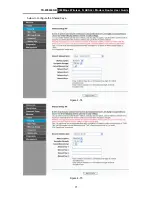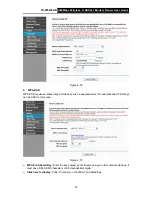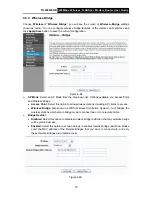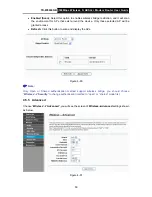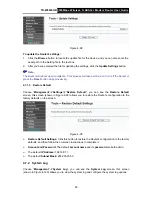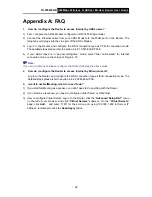
TD-W8960NB
300Mbps Wireless N ADSL2+ Modem Router User Guide
¾
Channel:
Select the channel you want to use from the drop-down List. This field determines
which operating frequency will be used. It is not necessary to change the wireless channel
unless you notice interference problems with another nearby access point.
¾
Mode
: In the drop-down list you can select “11b”, “11bg”, “11bgn” and "11n only”. “11bgn”
allows both 802.11b, 802.11g and 802.11n wireless stations to connect to the Router.
¾
Bandwidth
: Select the Bandwidth you want to use from the drop-down List. If bigger
bandwidth is selected, device could transmit and receive data with higher speed.
¾
Control Sideband
: If bigger bandwidth is selected, this option will allow you select the
Control Sideband you want.
¾
Fragmentation Threshold:
This value specifies the maximum size for a packet before data
is fragmented into multiple packets. If you experience a high packet error rate, you may
slightly increase the Fragmentation Threshold. Setting the Fragmentation Threshold too low
may result in poor network performance. Only minor reduction of the default value is
recommended. In most cases, it should remain at its default value of 2346.
¾
RTS Threshold:
Should you encounter inconsistent data flow, only minor reduction of the
default value 2347 is recommended. If a network packet is smaller than the preset RTS
threshold size, the RTS/CTS mechanism will not be enabled. The Router sends Request to
Send (RTS) frames to a particular receiving station and negotiates the sending of a data
frame. After receiving an RTS, the wireless station responds with a Clear to Send (CTS)
frame to acknowledge the right to begin transmission. In most cases, keep its default value of
2347.
¾
DTIM Interval:
This value, between 1 and 255, indicates the interval of the Delivery Traffic
Indication Message (DTIM). A DTIM field is a countdown field informing clients of the next
window for listening to broadcast and multicast messages. When the Router has buffered
broadcast or multicast messages for associated clients, it sends the next DTIM with a DTIM
Interval value. Its clients hear the beacons and awaken to receive the broadcast and multicast
messages. The default value is 1.
¾
Beacon Interval:
Enter a value between 20-1000 milliseconds. The Beacon Interval value
indicates the frequency interval of the beacon. A beacon is a packet broadcast by the Router
to synchronize the wireless network. The default value is 100.
¾
Transmit Power:
This option will allow you to configure the wireless transmit power. High
transmit power will extend the wireless signal range of the device and make the signal
transmit more legible. Low transmit power with the smaller wireless signal range that will
decrease the probability of interrupt by other Wi-Fi device.
¾
WMM (Wi-Fi Multimedia):
This function can guarantee the packets with high-priority
messages being transmitted preferentially. It is strongly recommended.
4.5.6 Station info
Choose “
Wireless
”
Æ
”
Station Info
”, you will see the screen of
Wireless--Authenticated
Stations
setting shown as below.
81





